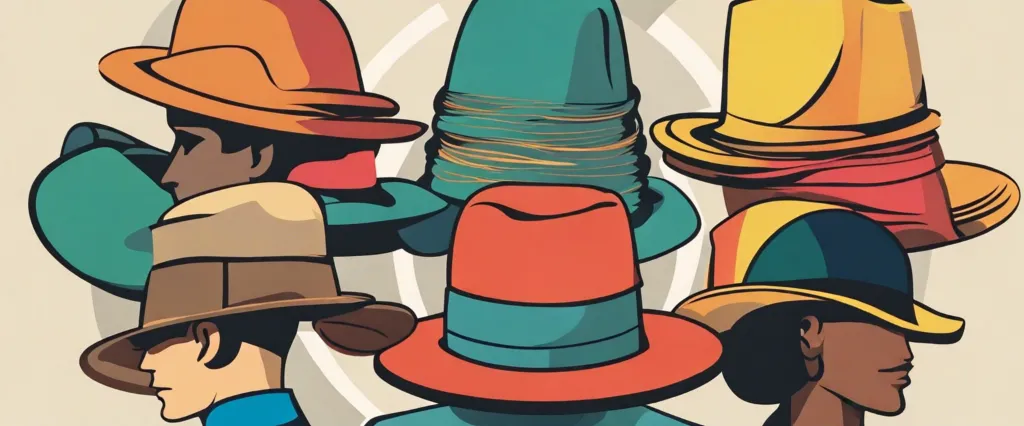In “Six Thinking Hats” written by Edward De Bono, readers are introduced to a practical and innovative method for enhancing their thinking and decision-making skills. This gripping book equips individuals with six unique thinking hats, each representing a different perspective, allowing them to effectively analyze problems, generate creative solutions, and collaborate more efficiently. Renowned around the world as a leading authority on creative thinking and problem-solving, Edward De Bono has written over eighty books on various aspects of thinking, including “Lateral Thinking” and “Serious Creativity.” As a respected philosopher, psychologist, and consultant, De Bono’s ground-breaking work has significantly influenced numerous industries and transformed the way we approach challenges.
Chapter 1: Introduction to Six Thinking Hats Method
The chapter outlines the purpose of the method and its benefits, as well as providing an overview of the six thinking hats and their functions.
The author begins by highlighting the need for a structured approach to thinking and communication in order to effectively tap into the collective intelligence of a group. He argues that traditional methods often result in unproductive arguments and ego clashes, leading to wasted time and energy. The Six Thinking Hats method aims to counter these challenges and promote more efficient, focused, and constructive thinking.
De Bono introduces the concept of six different colored hats, each representing a specific mode of thinking. These six hats are: the white hat for facts and data, the red hat for emotions and intuition, the black hat for critical judgment, the yellow hat for optimistic and positive perspectives, the green hat for creative and innovative ideas, and the blue hat for facilitation and organization.
The author explains that by consciously wearing one hat at a time, individuals or groups can explore different angles of a problem or decision. This approach allows for a more balanced and comprehensive examination, as it separates out distinct thinking patterns and prevents them from overlapping or conflicting with each other.
De Bono promotes the idea that all participants in a discussion or decision-making process should adopt the same hat at the same time. By doing so, everyone is encouraged to think in alignment with the chosen mode, which fosters clarity, respect, and effective collaboration within the group.
In conclusion, The book’s aim is to enhance individual and group thinking processes, leading to more effective communication, improved decision-making, and better problem-solving outcomes.
Chapter 2: The White Hat: Focusing on Facts and Information
The chapter begins by emphasizing the importance of gathering accurate information before making any judgments or decisions. The white hat thinking encourages individuals to approach a situation with curiosity and a desire to uncover all relevant facts. The author emphasizes that by wearing the white hat, thinkers can detach themselves from personal biases, opinions, and emotions that can cloud their judgment.
De Bono introduces various techniques to effectively gather information through the white hat thinking. These techniques include conducting research, collecting data, asking relevant questions, and considering multiple perspectives. The chapter also emphasizes the importance of differentiating between facts and assumptions.
Furthermore, the author highlights the significance of using the white hat thinking in groups and teams. By encouraging everyone to wear the white hat, teams can ensure a comprehensive and impartial examination of facts and figures. This approach reduces the chances of missing crucial information or making decisions based on faulty assumptions.
By focusing on facts, information, and unbiased analysis, individuals and teams can make more informed choices and minimize the impact of personal biases. The chapter serves as an essential guide for effectively incorporating the white hat thinking into problem-solving processes.
Chapter 3: The Red Hat: Exploring Emotions and Intuition
The chapter begins by emphasizing the importance of acknowledging and discussing emotions, which are often neglected in decision-making processes. De Bono highlights that emotions can greatly influence our thoughts and actions, and considering them explicitly can improve the decision-making process.
The red hat encourages individuals to express their emotions and intuition freely without the need for justification or logic. It allows people to share their gut feelings, fears, hopes, and any other emotional responses to a particular situation.
The red hat plays a significant role in highlighting potential risks and concerns. By inviting participants to openly discuss their emotions and intuitions, it enables a more holistic understanding of a situation, going beyond the purely analytical aspects. This can help identify potential downsides, unaddressed concerns, or areas requiring caution.
Furthermore, the red hat acts as a prompt for creative and imaginative thinking. By tapping into intuition and emotions, individuals can generate innovative ideas and solutions that may be overlooked by purely rational thinking.
It helps bring a more comprehensive perspective, considering not only logical arguments but also the array of emotions and intuitions individuals bring to the table. By incorporating the red hat thinking, teams can make more informed decisions that consider both the rational and emotional aspects of a situation.
Chapter 4: The Black Hat: Identifying Risks and Potential Problems

The Black Hat represents the need to objectively assess risks, problems, and potential pitfalls in any situation.
Edward De Bono emphasizes the importance of this hat as a counterbalance to the optimistic and positive thinking represented by the other hats. The Black Hat allows individuals to realistically identify and address any potential issues before they arise. By wearing the Black Hat, individuals can analyze problems from a neutral standpoint without any emotional bias.
The chapter explains that the Black Hat allows for a disciplined and comprehensive assessment of risks and problems. It encourages individuals to think critically and objectively, examining all potential drawbacks, weak points, and negative consequences. It prompts individuals to ask questions such as “What could go wrong?” or “What obstacles might we face?”
Moreover, De Bono asserts that the Black Hat enables individuals to identify potential risks in a proactive manner and develop contingency plans. By anticipating and preparing for negative outcomes, individuals can increase their chances of achieving success while minimizing the impact of any problems that may arise.
It encourages individuals to objectively analyze situations and prepare for any negative outcomes. By incorporating this hat into their thinking process, individuals can enhance their decision-making abilities and effectively manage challenges.
Chapter 5: The Yellow Hat: Embracing Optimism and Possibilities
The yellow hat encourages individuals to focus on the potential benefits and advantages of a particular idea or situation. It is about looking at things from a positive perspective and seeking out opportunities rather than dwelling on the negatives. According to De Bono, this optimistic viewpoint is crucial in promoting creativity and effective decision-making.
By wearing the yellow hat, individuals are encouraged to actively explore potential benefits, seek out possibilities, and anticipate positive outcomes. It is a way of shifting one’s mindset towards optimism and encouraging a proactive approach to problem-solving. De Bono emphasizes that the yellow hat helps to counterbalance the more critical and cautious thinking represented by other hats, such as the black hat (representing caution and negative thinking).
Additionally, the yellow hat helps to break free from limiting thoughts and traditional patterns of thinking. It pushes individuals to think beyond what is currently known or accepted. By embracing optimism and possibilities, people can generate new ideas, explore creative solutions, and inspire others to think in a similar manner.
It encourages individuals to adopt a proactive mindset, seek out potential benefits, and think beyond the limitations of conventional thinking.
Chapter 6: The Green Hat: Encouraging Creativity and Innovation
The author starts by highlighting the importance of creativity and innovation in problem-solving and decision-making processes. He emphasizes that creativity is not limited to artists or designers but is a skill that can be cultivated by anyone. The Green Hat provides a structured approach to unlocking creative thinking abilities.
De Bono introduces several techniques that can be used with the Green Hat, such as brainstorming and lateral thinking. Brainstorming involves generating a large number of ideas without judgment or criticism. This allows for the exploration of unconventional ideas that may lead to breakthrough solutions.
The author also introduces the concept of lateral thinking, which involves solving problems through indirect and creative approaches. Lateral thinking encourages us to challenge assumptions and consider alternative perspectives. This type of thinking encourages us to break free from traditional ways of thinking and explore new possibilities.
De Bono emphasizes the importance of using the Green Hat effectively within a group setting. He outlines guidelines for conducting productive brainstorming sessions, such as setting clear goals, encouraging equal participation, and deferring judgment. By following these guidelines, teams can foster an environment that encourages creativity and innovation.
By adopting this thinking style, individuals and teams can generate new ideas, explore unconventional solutions, and challenge traditional thinking patterns. Through techniques like brainstorming and lateral thinking, the Green Hat allows for the exploration and development of innovative ideas.
Chapter 7: The Blue Hat: Facilitating Thinking and Decision-Making
The Blue Hat is responsible for ensuring that the Six Hats method is effectively applied and that the discussion remains focused and productive.
The chapter begins by outlining the key responsibilities of the Blue Hat, which include setting the agenda, defining the focus of the discussion, and controlling the timing and sequence of the hat switch. The Blue Hat also summarizes and evaluates the outcomes of each hat and keeps the overall goals and objectives in mind.
De Bono emphasizes the importance of the Blue Hat’s neutrality and impartiality. The Blue Hat should refrain from expressing personal opinions and instead encourage all participants to contribute their thoughts and perspectives freely. This helps to create an inclusive and collaborative environment where each hat is given an equal opportunity to be heard.
In addition to its role in managing the process, the Blue Hat can also act as a participant by wearing a hat and contributing to the discussion. However, the Blue Hat must remember to switch back to the role of facilitator when necessary.
The chapter provides practical advice for effective Blue Hat thinking, such as preparing an agenda in advance, using visual aids to structure the discussion, and encouraging participants to switch hats actively. The Blue Hat should also consider the timing and duration of each hat to ensure a balanced and comprehensive exploration of the topic.

Chapter 8: Applying the Six Thinking Hats Method in Practice
The chapter begins by outlining the different scenarios in which the Six Thinking Hats can be employed, such as during meetings, brainstorming sessions, problem-solving exercises, and decision-making processes. De Bono highlights how the Six Thinking Hats help individuals and teams focus their thinking and overcome the limitations of their own biases and preconceptions.
The author provides practical guidance on how to use the method effectively. He suggests that the facilitator or leader should clearly define the focus or purpose of the discussion before proceeding. Then, each participant should examine the topic or problem from one specific “hat” perspective at a time, ensuring that all viewpoints are thoroughly explored. De Bono advises that participants should avoid mixed thinking (using two or more hats simultaneously) to maintain clarity and create productive discussions.
The chapter also delves into the benefits and potential pitfalls of the Six Thinking Hats approach. De Bono highlights that the method increases engagement, participation, and creativity within a group. Moreover, it facilitates a more objective and holistic evaluation of ideas. However, the author cautions against the possible risk of participants becoming overly attached to a single hat, which can hinder the exploration of other perspectives.
By employing this structured approach to thinking, individuals and groups can enhance their decision-making processes, foster innovation, and create a more collaborative environment.
After Reading
In conclusion, “Six Thinking Hats” by Edward de Bono provides a practical and effective framework for organizing, managing, and enhancing group discussions and decision-making processes. By assigning different thinking roles represented by different colored hats, de Bono empowers individuals to analyze problems from various perspectives and encourages collaborative thinking. This book serves as a valuable tool for individuals and organizations seeking to improve communication, creativity, and problem-solving skills. Through the implementation of the Six Thinking Hats approach, teams can foster a more cohesive and productive environment, ultimately leading to better decision-making outcomes. Overall, “Six Thinking Hats” offers a fresh and innovative approach to critical thinking, making it a must-read for anyone interested in enhancing their thinking processes.
Book Recommendation:
1. Predictably Irrational” by Dan Ariely – This book offers an insightful exploration of the irrational behaviors that influence our decision-making processes. With engaging anecdotes and thought-provoking studies, Ariely challenges the assumption of rationality and exposes the hidden forces shaping our choices.
2. Think Again” by Adam M. Grant – Drawing from psychology, sociology, and cognitive science, Grant encourages readers to embrace the power of rethinking. By challenging our beliefs, questioning assumptions, and being open to new ideas, we can enhance our perspectives and make better decisions in our personal and professional lives.
3. Sources of Power” by Gary Klein – In this groundbreaking work, Klein investigates how experts make critical decisions under time pressure and uncertainty. Exploring real-life examples from various high-risk fields, Klein unveils the decision-making process, highlighting the importance of experience, intuition, and rapid cognition in complex situations.
4. Influence: The Psychology of Persuasion” by Robert B. Cialdini – This classic book delves into the principles behind the art of persuasion. Cialdini explores different psychological tactics, such as reciprocity, social proof, and scarcity, shedding light on how they influence our choices and behavior. A must-read for anyone interested in understanding the power of persuasion.
5. Nudge: Improving Decisions About Health, Wealth, and Happiness” by Richard H. Thaler and Cass R. Sunstein – Focusing on behavioral economics, this book examines how subtle nudges can lead to positive changes in decision-making. Thaler and Sunstein present captivating examples and practical strategies to help individuals and organizations make better choices in their lives and society.
These five books offer a diverse and comprehensive exploration of decision-making, irrational behaviors, persuasion, and cognitive biases. Each book complements “Six Thinking Hats” by Edward De Bono by providing unique insights and practical ideas for improving our thinking processes.




